

Strategies to Build Intrinsic Motivation. Punishment, Rewards, and Commitment The issue with classroom management policies in most institutions is that it operates on a carrot-and-stick model.
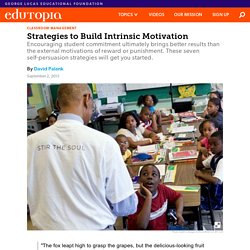
Learning by Doing: Students Write a Guide to Teen Psychology. It’s always awe-inspiring when students take hold of a project and are given the power to lead it.

They set goals, delegate, lead discussions, and critique each other’s work as if that were a normal process. I’ve just seen this with the eighth-grade social studies students at Shanghai American School. The students at my school have been engaged in a project in their class around the topic of psychology. While this might seem to be outside the normal social studies curriculum, the teachers are experimenting with the adoption of the College, Career, and Civic Life (C3) Framework for Social Studies State Standards. Changing parent perceptions of classroom practice. Involving parents more in the day-to-day learning of their children could help to change perceptions about teachers’ capabilities and what they do in the classroom.

Reporting the findings of an annual survey of Australian parents, grandparents and guardians, Monash University academics Associate Professor Shane Phillipson and Associate Professor Sivanes Phillipson say 84 per cent think their child’s teacher is highly educated but a smaller number don’t agree. ‘The concerns of such parents are related to their belief that teachers are sometimes unable to deal with children who show signs of behavioural issues, helping their child remain focussed and the capacity of the teacher to engage their child in learning subjects such as mathematics and other skills that are considered to be the “basics”. The 2016 study asked more than 3000 participants for their views on a range of education-related topics, including resources, homework and the greatest challenges facing their child’s learning.
Edutopia. Student: I opened it up, and there was a root inside.
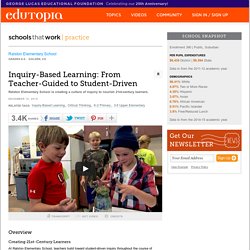
Anne: What's exciting about the inquiry models that we go far and above what the curriculum expectations are. Kids are invested in their learning, and they're able to transfer and apply what they're learning in school to the real world. Lindsay: Inquiry based learning allows the students to be the thinkers. Teachers begin their lesson with an idea of where they want to end in mind, but really give the students the opportunity to drive it to that point. The Building Blocks Of A Responsive Approach To Schoolwide Behavior - Edutopia. How do children learn to care enough about others that they reap the personal rewards associated with giving?
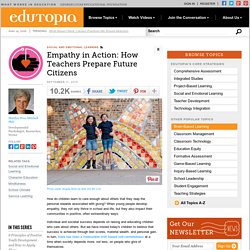
Edutopia. What should you do if you are a school counselor, administrator, principal, or teacher interested in bringing mindfulness programming to your whole school?
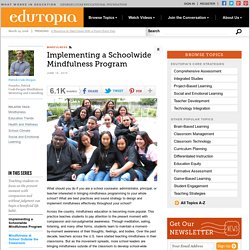
What are best practices and sound strategy to design and implement mindfulness effectively throughout your school? Across the country, mindfulness education is becoming more popular. This practice teaches students to pay attention to the present moment with compassion and non-judgmental awareness. Turning 32 Years Into 6 Simple Takeaways. Teacher Advice?

A Teacher Reflects Back On 32 Years And Offers 6 Simple Nuggets Of Advice by Sharon Davison, Kindergartenlife Blog Our first entry from our Diverse Teacher Voices program comes from Sharon Davison, a Kindergarten teacher from Vermont who responded to the “Dear First Year Me” prompt. For Sharon, there is some increased significance–or rather, there’s significance for each one of us as readers. Gratitude Can Fuel School Transformation. One of the most common complaints I hear from teachers, administrators, and staff working in public schools is something along the lines of, "I don't feel appreciated.
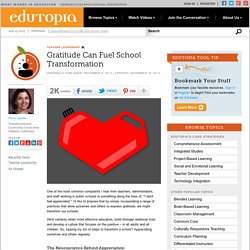
" I'd like to propose that by simply incorporating a range of practices that allow ourselves and others to express gratitude, we might transform our schools. We'd certainly retain more effective educators, build stronger relational trust, and develop a culture that focuses on the positive -- in all adults and all children. So, topping my list of steps to transform a school? Appreciating ourselves and others regularly. The Neuroscience Behind Appreciation Here's the thing: Our brains need to feel gratitude in order for us to want to be at work. As we strengthen these links and build them day-after-day, our mind finds it easier to travel down those neural paths and to experience the associated positive emotions. If we feel more positive, we will want to be at work. "Gratitude is like a flashlight.
Ways of Practicing Gratitude. Resources to Fight Bullying and Harassment at School. Each October, individuals and organizations nationwide work together to raise awareness of bullying during National Bullying Prevention Month, an initiative of the PACER Center.

Whether you are an educator, education leader, parent, or other community member, you can take action to prevent bullying and harassment by fostering a culture of caring and respect in your school, home, and community. Use the resources below to support your efforts. In addition, consider participating in Edutopia's community to share your own insights and resources about bullying prevention. Resources for Educators Take a look at the infographic "Bullying: What You Need to Know," courtesy of StopBullying.gov, a U.S. government website, for information about some of the statistics behind bullying and impacts on children.
The resources from StopBullying.gov address detection, preventive strategies, and effective responses. Bullying Prevention Curriculum. 8 Tips for Schools Interested in Restorative Justice. Restorative justice is an effective alternative to punitive responses to wrongdoing.
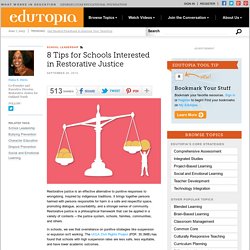
Inspired by indigenous traditions, it brings together persons harmed with persons responsible for harm in a safe and respectful space, promoting dialogue, accountability, and a stronger sense of community. Restorative justice is a philosophical framework that can be applied in a variety of contexts -- the justice system, schools, families, communities, and others.
In schools, we see that overreliance on punitive strategies like suspension or expulsion isn't working. The UCLA Civil Rights Project (PDF, 30.3MB) has found that schools with high suspension rates are less safe, less equitable, and have lower academic outcomes. In a January 2014 school guidance package, U.S. Zero-tolerance policies may seem like the answer to bad behavior in the heat of the moment. 1. What can schools do about bullying? Team leaders: Jonathon Magrath and Sophie Goldrick, year 10 students at Koonung Secondary College, are helping to trial the Peaceful Schools Program there. Photo: Joe Armao It started, as is so often does with girls, with a whispering campaign. The gossiping was endless. "Everything I seemed to do was something to talk about. The girls would nudge each other and say: 'Shhhh, Amelia* is there'.
" A delegation of girls told a teacher that Amelia was being bullied. As she had feared, things got worse. Amelia's mother says the bullies made her daughter's life hell. Amelia's family met her teachers. Research by the Australian Institute of Family Studies this year found one in three ten-year-olds said they had been bullied in Australian schools. "It is now widely acknowledged that bullying is not limited to physical forms of aggression but includes verbal and indirect forms such as deliberate and unfair exclusion - and that the latter can be the most devastating.
*Names have been changed. Dos and Don'ts of Classroom Management: Your 25 Best Tips - Google Slides. 7 Survival Skills For Modern Teachers And Students. Walk into a school, airport, shopping mall, or even a church and the image is always the same, teens and tweens have their heads down, ear buds on, and a mobile device in their hand. The Complete Visual Guide To Generation Z. There’s always discussion happening out there about generational differences, especially when it comes to internet and technology usage. Much of this discussion tends to divide people into two (very rough) groups – of older and younger, superusers and reluctant users, and a very very large grey area in between.
That’s not to say that there’s nothing out there that breaks it down more, but for the most part, we don’t see as much detail as we see generalizations. So I was interested when I came across this detail of Generation Z which this particular infographic defines as folks who were born between 1995 and 2009. Keep reading to learn more about one of the youngest generations. Commonly named life stages have been broken down into more categories than in the past. ChildhoodTweenTeenagerYoung AdultKippersAdultCareer-ChangerDownager. Restorative Justice: Resources for Schools. Restorative justice empowers students to resolve conflicts on their own and in small groups, and it's a growing practice at schools around the country.
Essentially, the idea is to bring students together in peer-mediated small groups to talk, ask questions, and air their grievances. (This four-part tutorial from the Centre for Justice and Reconciliation is a wonderful primer.)